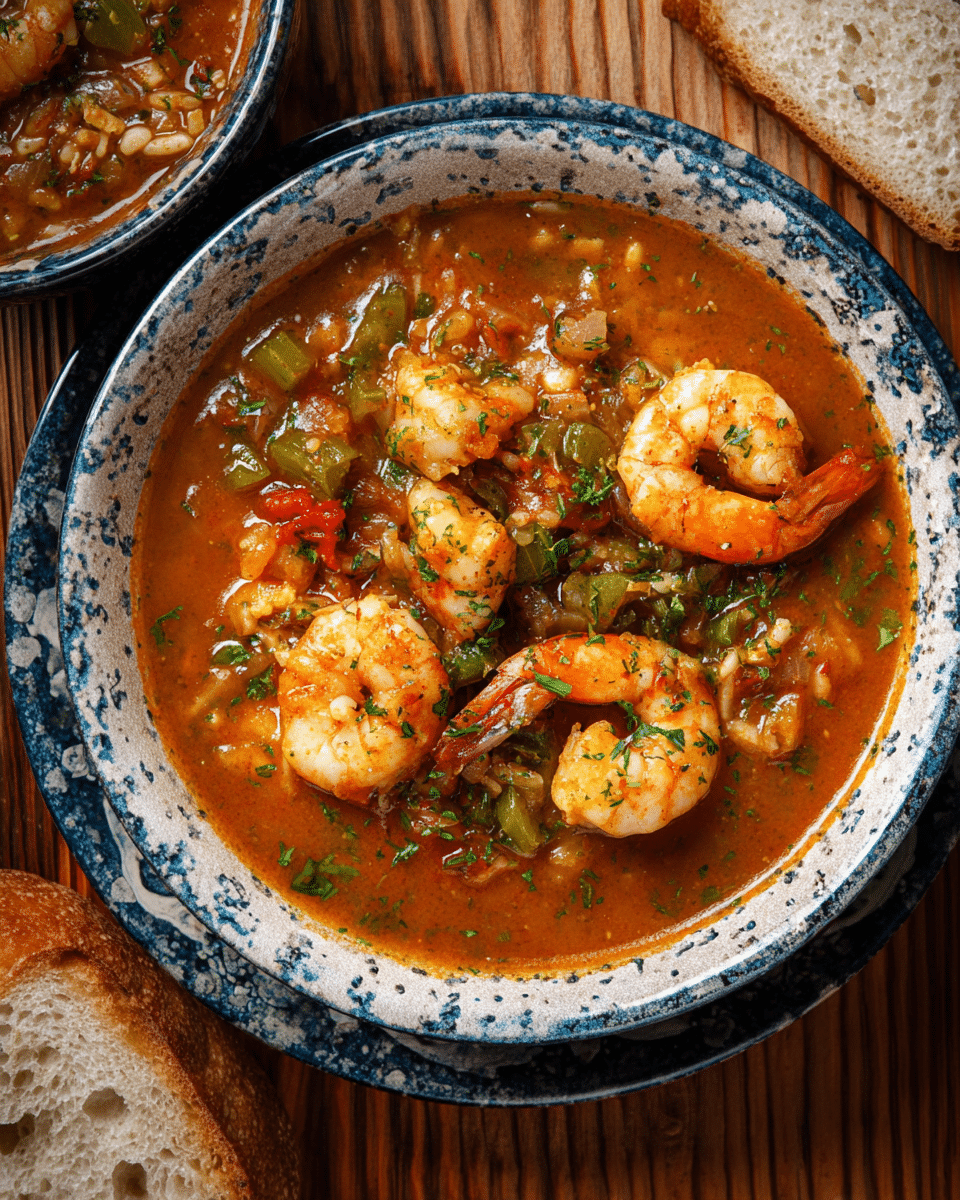The bold, unmistakable flavor of Shrimp Étouffée captures the heart of Louisiana cuisine in a single bite. With a rich, toasty roux and the aromatic “Holy Trinity” of vegetables, this dish brings together tradition and depth in every spoonful. It’s finished with a gentle kick of heat from jalapeños and hot sauce, making it a true comfort food classic.
Perfect for a cozy night in or a dinner party with soul, this Cajun staple delivers not just heat but layers of soulful flavor. The beauty of étouffée lies in its simplicity—one pot, a few well-chosen ingredients, and patience. Pair it with fluffy rice and maybe a cold beer for the ultimate Southern experience.
Full Recipe:
For the Optional Shrimp Stock:
-
Shells from 2 pounds of shrimp
-
1/2 large onion, chopped
-
Top and bottom from 1 green pepper
-
2 garlic cloves, chopped
-
1 celery rib, chopped
-
5 bay leaves
-
2 quarts water
For the Étouffée:
-
1/4 cup vegetable oil or lard
-
1 heaping 1/4 cup all-purpose flour
-
1 large rib celery, chopped
-
1 green bell pepper, chopped
-
1–2 jalapeño peppers, chopped
-
1/2 large onion, chopped
-
4 garlic cloves, chopped
-
2 cups shrimp stock (or clam/fish stock)
-
1 tablespoon Cajun seasoning
-
1/2 teaspoon celery seed
-
1 tablespoon sweet paprika
-
Salt to taste
-
2 pounds shrimp, peeled (shells used above)
-
3 green onions, chopped
-
Hot sauce (Crystal or Tabasco), to taste
Directions:
-
Make the optional shrimp stock: In a large pot, combine the shrimp shells, onion, green pepper scraps, garlic, celery, and bay leaves with 2 quarts of water. Bring to a boil, reduce heat, and simmer for 45 minutes. Strain and reserve 2 cups of stock.
-
Make the roux: Heat the oil or lard in a heavy-bottomed pot over medium heat. Stir in the flour and cook, stirring constantly, until the mixture becomes deep brown, about 10 minutes.
-
Add vegetables: Stir in the celery, green bell pepper, jalapeño, and onion. Cook for 4 minutes. Add garlic and sauté another 2 minutes.
-
Incorporate stock and seasonings: Slowly add the shrimp stock a little at a time, stirring constantly. The roux will tighten, then loosen. Continue until the sauce reaches a syrup-like thickness.
-
Add Cajun seasoning, celery seed, and paprika. Salt to taste. Stir in shrimp, cover, and cook on the lowest heat for 10 minutes.
-
Finish: Stir in green onions and hot sauce. Serve hot over white rice with a refreshing drink.
Prep Time: 20 minutes (if using pre-made stock) | Cooking Time: 45 minutes
Total Time: 65 minutes
Kcal: 320 kcal | Servings: 4 servings
A Deep Dive into Shrimp Étouffée: Louisiana’s Spicy Soul in a Bowl
Shrimp Étouffée is more than just a meal — it’s a cultural emblem that echoes the rhythm, heritage, and heat of Louisiana’s kitchens. If you’ve ever tasted the sultry richness of a well-made étouffée, you know the deep satisfaction it brings. But what lies beneath its bubbling surface isn’t just shrimp and spices — it’s a story of resilience, culinary evolution, and soulful expression.
What Is Étouffée?
The word étouffée comes from the French word étouffer, meaning “to smother.” And that’s exactly what this dish is — shrimp smothered in a thick, savory sauce made from a classic Cajun or Creole roux. It walks the line between a stew and a fricassée, offering richness without heaviness, spice without fire, and depth without complexity.
Where gumbo might be bold and communal, étouffée feels personal — it simmers gently, thickens slowly, and nourishes deeply. It’s a culinary lullaby, humming quietly on the stove until it’s ready to be ladled over hot, fluffy rice.
The Cajun-Creole Roots
To understand shrimp étouffée is to understand the dual culinary identity of Louisiana. Cajun and Creole cuisines often get intertwined, but they come from distinct cultural origins. Creole food developed in urban New Orleans, influenced by French, Spanish, African, and Caribbean traditions. It tends to be more tomato-forward, refined, and globally inspired.
Cajun cuisine, on the other hand, stems from French Acadians who settled in rural Louisiana. Their cooking leans rustic, resourceful, and boldly seasoned. Étouffée fits neatly into the Cajun side of this dichotomy, though Creole variations exist.
In most traditional Cajun versions, there’s no tomato — just roux, aromatics, stock, spices, and the protein of choice, often shrimp or crawfish. The result is an earthy, smoky, slow-simmered sauce that hugs each piece of seafood.
The Power of the Roux
The foundation of étouffée is its roux — a simple blend of flour and fat (usually oil or lard) cooked to a deep, toasty brown. This process transforms the flavor from bland to nutty, adding a profound depth to the final dish. While the French may use light or blonde roux in classical sauces, Cajun roux is darker, richer, and more flavorful — and mastering it is almost a rite of passage.
The roux in shrimp étouffée isn’t just a thickener; it’s a flavor base. Cooked to the color of chocolate, it carries smoky notes that are unmistakably Louisianan. Stirring the roux requires attention and patience, as it can burn in a heartbeat. But once done right, it’s a game-changer.
The “Holy Trinity” of Louisiana Cooking
No Louisiana dish is complete without its aromatic backbone: onion, celery, and bell pepper — affectionately known as the “Holy Trinity.” This trio replaces the French mirepoix (onion, celery, carrot) and adds a Southern snap of green flavor.
In étouffée, the Holy Trinity is sautéed directly in the roux, allowing the vegetables to absorb the complex flavors. Garlic often joins the mix, bringing additional richness to the base. When these ingredients hit the pot, you’re no longer cooking — you’re conjuring.
Shrimp: The Star of the Dish
Shrimp étouffée isn’t just about the sauce — it’s about the shrimp. Gulf shrimp, in particular, are prized for their sweet, briny flavor and tender texture. Whether you’re in the bayous of Louisiana or thousands of miles away, choosing fresh or high-quality shrimp makes a huge difference.
The shrimp is typically added toward the end of cooking, just enough to poach in the sauce without becoming rubbery. In many households, the shells are saved to make a homemade shrimp stock, adding another layer of oceanic intensity.
Some cooks even use crawfish or a mix of shellfish. But shrimp remains the most beloved and accessible choice — a perfect canvas for the smoky, spicy sauce.
Spices, Heat, and Customization
Cajun seasoning is the heart of this dish. While spice blends vary, most include paprika, cayenne, garlic powder, black pepper, and oregano. The goal isn’t to overwhelm with heat but to build a warm, peppery complexity that lingers on the tongue.
Jalapeños and hot sauce add more heat, but the level is up to the cook. Crystal and Tabasco are both traditional choices. A good shrimp étouffée should make your mouth tingle — not burn. The best ones leave you wanting another spoonful, not a glass of milk.
Seasoning is deeply personal in Louisiana kitchens. Each family has their ratios, each pot has its quirks. That’s part of what makes this dish so adaptable — you can tailor the spice, the salt, even the consistency to your liking.
Serving Suggestions and Sides
Shrimp étouffée is almost always served over white rice — a neutral bed that soaks up the flavorful sauce. The contrast between fluffy grains and silky roux is part of what makes the dish sing.
For sides, simple is best. A hunk of crusty French bread, some sautéed greens, or a cold beer are all welcome additions. In Louisiana, the meal might end with bread pudding or a slice of pecan pie.
Why Shrimp Étouffée Is a Comfort Food Classic
It’s hard to describe just how satisfying a bowl of shrimp étouffée can be. It doesn’t rely on fancy ingredients or modern techniques. It’s grounded in tradition, slow-cooked flavor, and culinary storytelling.
What makes it truly comforting is its honesty. It’s made from scratch, with time and care. It smells like home, feels like family, and tastes like a dish that’s been passed down for generations. It’s the kind of meal that calls you back to the table even after you’re full — just for one more spoonful.
Modern Variations and Global Reach
Though deeply rooted in Louisiana, shrimp étouffée has traveled far beyond the bayou. Chefs and home cooks alike have embraced it, tweaking the base recipe to suit modern palates. Some add cream for richness, others introduce smoked sausage, crab, or even tofu for a plant-based spin.
Gluten-free roux substitutes and low-sodium stock make it more inclusive. Despite these changes, the soul of the dish remains intact: a slow, smothered celebration of shrimp and spice.
Its appeal has even reached international kitchens, where chefs experiment with local seafood and herbs, merging Cajun technique with global flavors. From California to Copenhagen, étouffée continues to inspire.
Conclusion: Why You Should Make Shrimp Étouffée
Shrimp Étouffée is more than a dish — it’s an experience. It tells the story of a region shaped by French, African, Caribbean, and Native American influences. It showcases the power of simplicity: humble ingredients, bold technique, and a devotion to taste.
Whether you’re cooking it for the first time or the fiftieth, shrimp étouffée rewards you with warmth, flavor, and a deep sense of culinary connection. It’s a dish that honors where it came from while making space for where it’s going.
If you’re looking to cook something soulful, memorable, and universally loved, shrimp étouffée might just be your new favorite. It’s not just comfort food — it’s culture, served by the spoonful.






